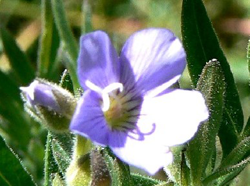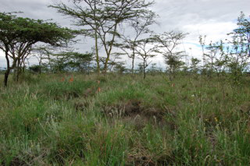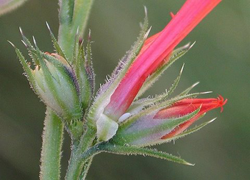
Page last updated: August 6, 2017
All pages copyright © 2017 by Alison K. Brody


My research explores how plant interactions with multiple species (including mutualist pollinators and antagonist seed predators, herbivores, and nectar robbers) affect flowering plant ecology and evolution of floral traits. Although we generally think of flowering traits evolving strictly in the context of plant interactions with pollinators, antagonists exert important selection on floral phenotypes as well. I’ve conducted most of my work at the Rocky Mountain Biological Laboratory near Crested Butte, Colorado.
MULTI-SPECIES INTERACTIONS:
ECOLOGICAL AND EVOLUTIONARY CONSEQUENCES

Gothic, Colorado
Effects of mutualists and antagonists on the persistence of females in gynodioecious populations of Polemonium foliosissimum.
SEX UNDER SIEGE
 I’m intrigued by the links between floral mutualists and antagonists in the stability
of plant mating systems. Along with colleagues Bob Dorsett and former PhD student,
Gretel Clarke, I’ve been examining those links in a gynodioecious plant, Polemonium
foliosissimum (Sticky Polemonium). In gynodioecious plants most individuals are hermaphrodites
and others are female (having lost male function). These plants provide an opportunity
to examine extreme phenotypic differences in floral traits and the role of species
interactions in trait selection and maintenance of gender morphs. Most recently,
I’ve gotten interested in how pollen thieving flies affect gender expression and
functional sex-ratios in Sticky polemonium.
I’m intrigued by the links between floral mutualists and antagonists in the stability
of plant mating systems. Along with colleagues Bob Dorsett and former PhD student,
Gretel Clarke, I’ve been examining those links in a gynodioecious plant, Polemonium
foliosissimum (Sticky Polemonium). In gynodioecious plants most individuals are hermaphrodites
and others are female (having lost male function). These plants provide an opportunity
to examine extreme phenotypic differences in floral traits and the role of species
interactions in trait selection and maintenance of gender morphs. Most recently,
I’ve gotten interested in how pollen thieving flies affect gender expression and
functional sex-ratios in Sticky polemonium.
Theory tells us that female fitness must be significantly greater than that of hermaphrodites to compensate for the loss of male function. Are female fitness advantages accrued through enhanced pollination? A reduction in seed predation? How much does the sex-ratio of the population and/or phenological differences among genders matter to female and hermaphrodite reproductive success?
Since 2001, I have been exploring the role of subterranean termites as ecological engineers of savannah grasslands in East Africa. Through their mound-building activities, termites generate habitat heterogeneity that, in turn, supports a diverse community of plants and invertebrates. In collaboration with Dan Doak, Todd Palmer, Kena Fox-Dobbs, Rob Pringle, and Charles Warui, our work has revealed that termites are significant drivers of plant and invertebrate species abundance, co-occurrence, and reproductive success, and their effects scale up from populations to ecosystems. Our work has been conducted in the black cotton soils at the Mpala Research Center, near Nanyuki Kenya.
When keystone species collide: effects of termites and herbivores on biological diversity in East African savannas
TERMITES - ECOLOGICAL ENGINEERS


Interactions with pre-dispersal seed predators, nectar robbers, herbivores, and pollinators.
IPOMOPSIS AGGREGATA - “SCARLET GILIA”
 One of the focal species of my work is the monocarpic perennial plant, Ipomopsis aggregata—commonly known as “scarlet gilia”. In various collaborations with Diane Campbell, Rebecca Irwin, Mary Price and Nick Waser, I have examined a suite of questions about the simultaneous effects of pre-dispersal seed predators, nectar robbing bumble bees, deer herbivores, and hummingbird pollinators on floral traits and the long-term, multi-generational success of scarlet gilia.
One of the focal species of my work is the monocarpic perennial plant, Ipomopsis aggregata—commonly known as “scarlet gilia”. In various collaborations with Diane Campbell, Rebecca Irwin, Mary Price and Nick Waser, I have examined a suite of questions about the simultaneous effects of pre-dispersal seed predators, nectar robbing bumble bees, deer herbivores, and hummingbird pollinators on floral traits and the long-term, multi-generational success of scarlet gilia. Effects of Mycorrhyizal fungi on floral trait expression in blueberry (Vaccinium corymbosum)
BELOW & ABOVE GROUND IN THE BLUEBERRY PATCH
 The association between mycorrhizal fungi and their host plants is an ancient one
and, most often, mutualistic. Mycorrhizal fungi gather nutrients from the soil in
exchange for photosynthetic carbon and often affect their host plant’s resource budget.
Although their role in nutrients acquisition, drought tolerance and tolerance of
heavy metals has been long-established, we are only beginning to discover the ways
in which these fungi affect host plant interactions with aboveground mutualists such
as pollinators. I am interested in how mycorrhizal fungi specific to members of the
Ericaceae (called ‘ericoids’) affect flowering traits and floral rewards important
to pollination and plant reproductive success in highbush blueberry. With colleagues
Jeanne Harris, Steve Keller, Taylor Ricketts, and Leif Richardson, I am exploring
the questions: How important are ericoids to floral traits and rewards? How specific
are the interactions between the fungal community that inhabits blueberry roots and
trait expression in their hosts? How important are mycorrhizae to phenotypic variation
and selection on traits formerly assumed to be under direct selection by pollinators?
The association between mycorrhizal fungi and their host plants is an ancient one
and, most often, mutualistic. Mycorrhizal fungi gather nutrients from the soil in
exchange for photosynthetic carbon and often affect their host plant’s resource budget.
Although their role in nutrients acquisition, drought tolerance and tolerance of
heavy metals has been long-established, we are only beginning to discover the ways
in which these fungi affect host plant interactions with aboveground mutualists such
as pollinators. I am interested in how mycorrhizal fungi specific to members of the
Ericaceae (called ‘ericoids’) affect flowering traits and floral rewards important
to pollination and plant reproductive success in highbush blueberry. With colleagues
Jeanne Harris, Steve Keller, Taylor Ricketts, and Leif Richardson, I am exploring
the questions: How important are ericoids to floral traits and rewards? How specific
are the interactions between the fungal community that inhabits blueberry roots and
trait expression in their hosts? How important are mycorrhizae to phenotypic variation
and selection on traits formerly assumed to be under direct selection by pollinators?